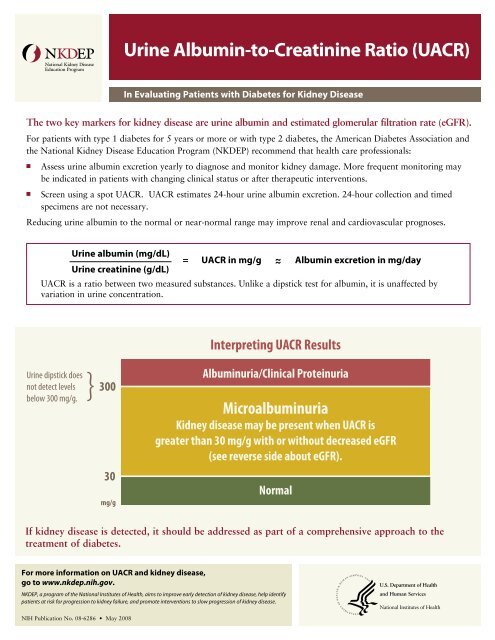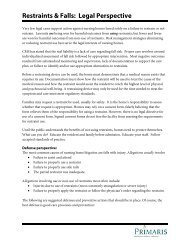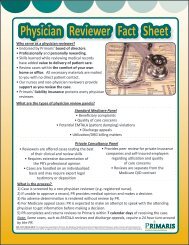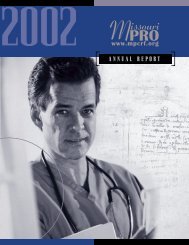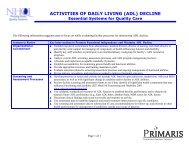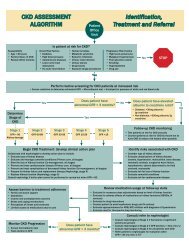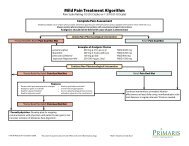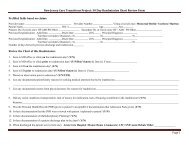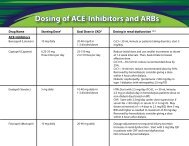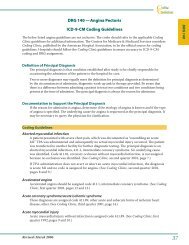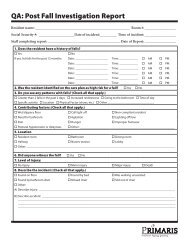Urine Albumin-to-Creatinine Ratio (UACR) - HealthInsight
Urine Albumin-to-Creatinine Ratio (UACR) - HealthInsight
Urine Albumin-to-Creatinine Ratio (UACR) - HealthInsight
You also want an ePaper? Increase the reach of your titles
YUMPU automatically turns print PDFs into web optimized ePapers that Google loves.
<strong>Urine</strong> <strong>Albumin</strong>-<strong>to</strong>-<strong>Creatinine</strong> <strong>Ratio</strong> (<strong>UACR</strong>)<br />
In Evaluating Patients with Diabetes for Kidney Disease<br />
The two key markers for kidney disease are urine albumin and estimated glomerular filtration rate (eGFR).<br />
For patients with type 1 diabetes for 5 years or more or with type 2 diabetes, the American Diabetes Association and<br />
the National Kidney Disease Education Program (NKDEP) recommend that health care professionals:<br />
n<br />
n<br />
Assess urine albumin excretion yearly <strong>to</strong> diagnose and moni<strong>to</strong>r kidney damage. More frequent moni<strong>to</strong>ring may<br />
be indicated in patients with changing clinical status or after therapeutic interventions.<br />
Screen using a spot <strong>UACR</strong>. <strong>UACR</strong> estimates 24-hour urine albumin excretion. 24-hour collection and timed<br />
specimens are not necessary.<br />
Reducing urine albumin <strong>to</strong> the normal or near-normal range may improve renal and cardiovascular prognoses.<br />
<strong>Urine</strong> albumin (mg/dL)<br />
<strong>Urine</strong> creatinine (g/dL)<br />
= <strong>UACR</strong> in mg/g ~ <strong>Albumin</strong> excretion in mg/day<br />
<strong>UACR</strong> is a ratio between two measured substances. Unlike a dipstick test for albumin, it is unaffected by<br />
variation in urine concentration.<br />
Interpreting <strong>UACR</strong> Results<br />
<strong>Urine</strong> dipstick does<br />
}<br />
not detect levels<br />
below 300 mg/g.<br />
300<br />
30<br />
mg/g<br />
<strong>Albumin</strong>uria/Clinical Proteinuria<br />
Microalbuminuria<br />
Kidney disease may be present when <strong>UACR</strong> is<br />
greater than 30 mg/g with or without decreased eGFR<br />
(see reverse side about eGFR).<br />
Normal<br />
If kidney disease is detected, it should be addressed as part of a comprehensive approach <strong>to</strong> the<br />
treatment of diabetes.<br />
For more information on <strong>UACR</strong> and kidney disease,<br />
go <strong>to</strong> www.nkdep.nih.gov.<br />
NKDEP, a program of the National Institutes of Health, aims <strong>to</strong> improve early detection of kidney disease, help identify<br />
patients at risk for progression <strong>to</strong> kidney failure, and promote interventions <strong>to</strong> slow progression of kidney disease.<br />
NIH Publication No. 08-6286 • May 2008<br />
KDEP recommends reporting<br />
Interpreting eGFR Results<br />
U.S. Department of Health<br />
and Human Services<br />
National Institutes of Health
Estimated Glomerular Filtration Rate (eGFR)<br />
<strong>Urine</strong> dipstick does<br />
}<br />
In Evaluating Patients with Diabetes for Kidney Disease<br />
not detect levels 300<br />
below 300 mg/g.<br />
The two key markers for kidney disease are eGFR and urine albumin.<br />
The American Diabetes Association and the National Kidney Disease Education Program (NKDEP) recommend<br />
that health care professionals:<br />
n<br />
Interpreting <strong>UACR</strong> Results<br />
<strong>Albumin</strong>uria/Clinical Proteinuria<br />
Microalbuminuria<br />
Kidney disease may be present when <strong>UACR</strong> is<br />
greater than 30 mg/g with or without decreased eGFR<br />
(see reverse side about eGFR).<br />
Calculate eGFR from stable serum creatinine levels at least once a year in all patients with diabetes.<br />
— eGFR is more accurate than serum creatinine alone. Serum creatinine is affected by muscle mass, and<br />
related fac<strong>to</strong>rs of age, sex, and race.<br />
— eGFR is not reliable for patients with normal kidney function, rapidly changing creatinine levels, or<br />
extremes in muscle mass and diet, e.g., very muscular or large people, cachectic people, and vegans.<br />
See if your lab reports eGFR routinely or if you need <strong>to</strong> request it. GFR calcula<strong>to</strong>rs are available on<br />
NKDEP’s website at www.nkdep.nih.gov.<br />
Interpreting eGFR Results<br />
NKDEP recommends reporting<br />
values greater than or equal<br />
<strong>to</strong> 60 as “>60,” rather than<br />
numeric values. Exact values<br />
above 60 are not reliable.<br />
60<br />
15<br />
ml/min/1.73 m 2<br />
Normal eGFR<br />
Kidney Disease<br />
Kidney disease may be present when eGFR is less than<br />
60 ml/min/1.73 m 2 , or if <strong>UACR</strong> exceeds 30 mg/g<br />
(see reverse side about <strong>UACR</strong>).<br />
Kidney Failure<br />
If kidney disease is detected, it should be addressed as part of a comprehensive approach <strong>to</strong> the<br />
treatment of diabetes.<br />
For more information on eGFR and kidney disease,<br />
go <strong>to</strong> www.nkdep.nih.gov.<br />
NKDEP, a program of the National Institutes of Health, aims <strong>to</strong> improve early detection of kidney disease, help identify<br />
patients at risk for progression <strong>to</strong> kidney failure, and promote interventions <strong>to</strong> slow progression of kidney disease.<br />
U.S. Department of Health<br />
and Human Services<br />
National Institutes of Health<br />
NIH Publication No. 08-6286 • May 2008


